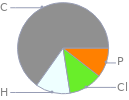Input interpretation

tetrabutylphosphonium chloride | elemental composition
Result

Find the elemental composition for tetrabutylphosphonium chloride in terms of the atom and mass percents: atom percent = N_i/N_atoms × 100% mass percent = (N_im_i)/m × 100% Plan: • Write the chemical formula and gather atomic masses from the periodic table. • Determine values for N_i, m_i, N_atoms and m using these items. • Finally, compute the percents and check the results. Write the chemical formula: (CH_3CH_2CH_2CH_2)_4P(Cl) Use the chemical formula to count the number of atoms, N_i, for each element and find the total number of atoms, N_atoms, per molecule: | number of atoms C (carbon) | 16 Cl (chlorine) | 1 H (hydrogen) | 36 P (phosphorus) | 1 N_atoms = 16 + 1 + 36 + 1 = 54 Divide each N_i by N_atoms to calculate atom fractions. Then use the property that atom fractions must sum to one to check the work: | number of atoms | atom fraction C (carbon) | 16 | 16/54 Cl (chlorine) | 1 | 1/54 H (hydrogen) | 36 | 36/54 P (phosphorus) | 1 | 1/54 Check: 16/54 + 1/54 + 36/54 + 1/54 = 1 Compute atom percents using the atom fractions: | number of atoms | atom percent C (carbon) | 16 | 16/54 × 100% = 29.6% Cl (chlorine) | 1 | 1/54 × 100% = 1.85% H (hydrogen) | 36 | 36/54 × 100% = 66.7% P (phosphorus) | 1 | 1/54 × 100% = 1.85% Look up the atomic mass, m_i, in unified atomic mass units, u, for each element in the periodic table: | number of atoms | atom percent | atomic mass/u C (carbon) | 16 | 29.6% | 12.011 Cl (chlorine) | 1 | 1.85% | 35.45 H (hydrogen) | 36 | 66.7% | 1.008 P (phosphorus) | 1 | 1.85% | 30.973761998 Multiply N_i by m_i to compute the mass for each element. Then sum those values to compute the molecular mass, m: | number of atoms | atom percent | atomic mass/u | mass/u C (carbon) | 16 | 29.6% | 12.011 | 16 × 12.011 = 192.176 Cl (chlorine) | 1 | 1.85% | 35.45 | 1 × 35.45 = 35.45 H (hydrogen) | 36 | 66.7% | 1.008 | 36 × 1.008 = 36.288 P (phosphorus) | 1 | 1.85% | 30.973761998 | 1 × 30.973761998 = 30.973761998 m = 192.176 u + 35.45 u + 36.288 u + 30.973761998 u = 294.887761998 u Divide the mass for each element by m to calculate mass fractions. Then use the property that mass fractions must sum to one to check the work: | number of atoms | atom percent | mass fraction C (carbon) | 16 | 29.6% | 192.176/294.887761998 Cl (chlorine) | 1 | 1.85% | 35.45/294.887761998 H (hydrogen) | 36 | 66.7% | 36.288/294.887761998 P (phosphorus) | 1 | 1.85% | 30.973761998/294.887761998 Check: 192.176/294.887761998 + 35.45/294.887761998 + 36.288/294.887761998 + 30.973761998/294.887761998 = 1 Compute mass percents using the mass fractions: Answer: | | | number of atoms | atom percent | mass percent C (carbon) | 16 | 29.6% | 192.176/294.887761998 × 100% = 65.17% Cl (chlorine) | 1 | 1.85% | 35.45/294.887761998 × 100% = 12.02% H (hydrogen) | 36 | 66.7% | 36.288/294.887761998 × 100% = 12.31% P (phosphorus) | 1 | 1.85% | 30.973761998/294.887761998 × 100% = 10.50%
Mass fraction pie chart

Mass fraction pie chart